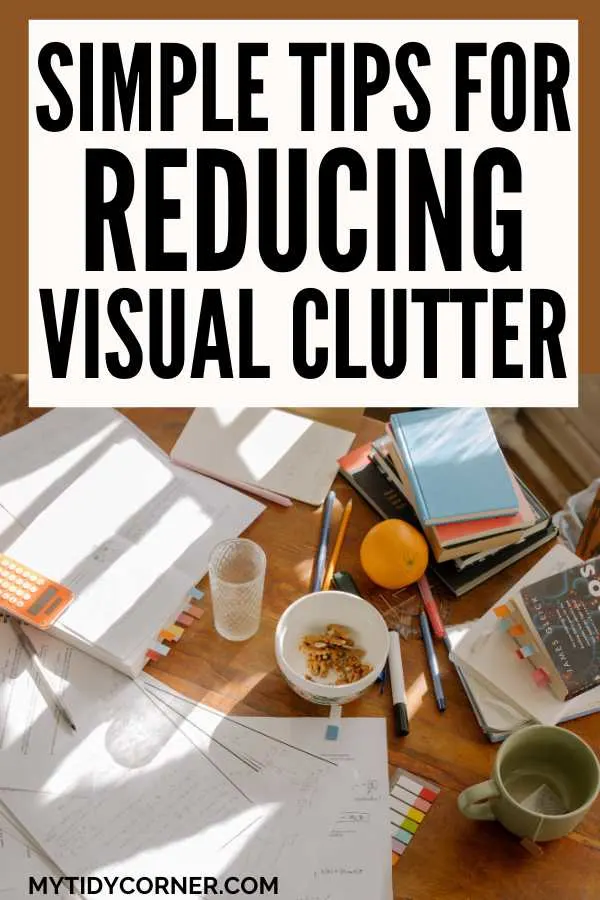Visual Clutter (What It is and How to Reduce It)
If you’ve ever felt overwhelmed by the chaos of your surroundings, we have the perfect practical tips on how to reduce visual clutter.
Home is where the heart is, but it’s also where life happens. From the moment we wake up to the time we go to bed, our homes are filled with activity, belongings, and visual stimuli. Over time, this can lead to a common issue known as visual clutter.
Visual clutter refers to the overwhelming and chaotic arrangement and accumulation of unnecessary or distracting visual elements within your living space. A cluttered workspace, uneven shelving, and excessive decorations can profoundly impact our well-being, productivity, and quality of life.
Understanding what visual clutter is, its impacts, and most importantly, how to effectively reduce it in order to create more organized and visually pleasing spaces is essential for that tranquillity we all seek.

What is Visual Clutter?
Let’s imagine this scenario for a minute. You step into your home after a long day at work. You’re greeted not by the warm embrace of a peaceful sanctuary but by the overwhelming sight of clutter.
The dining table is buried beneath a mountain of unopened mail, the kitchen counters cluttered with gadgets you hardly use, and the shelves filled with books that seem to have multiplied overnight.
It’s a familiar scene that has made me feel like I’m waging a daily battle against the relentless forces of chaos.
Struggling to find your keys amid the clutter or feeling a pang of frustration as you search for a specific kitchen utensil buried beneath an avalanche of cookware.
Visual clutter is a common yet often underestimated challenge we face within the very walls of our homes.
Visual clutter can manifest itself slowly over time until, one day, it disrupts the harmony and cleanliness of your living space.
- Piles of mail and paperwork on the dining table.
- Countertops cluttered with kitchen gadgets and appliances.
- An overflowing bookshelf where it’s hard to find your favorite novel.
- It’s a mishmash of furniture and decor styles that don’t quite mesh.
- Collection of unused candles that were once there to make your space feel more serene
- It is a collection that started out as something cute but turned into an obsession
- While plants add beauty and serenity to your home, too many neglected or overgrown houseplants can create visual clutter.
Essentially, it’s anything that makes your home feel chaotic, disorganized, and difficult to navigate.
What is the Impact of Visual Clutter?
The clutter that accumulates in our homes isn’t just an aesthetic concern. The impacts of visual clutter are far-reaching and can affect our well-being and various aspects of our daily lives.
These are some of the effects that can be caused by visual clutter in our homes.
- Stress and Anxiety: An unsightly, cluttered home can lead to increased stress and anxiety. The constant visual noise can overwhelm your senses, making it challenging to relax and unwind.
- Reduced Productivity: Visual clutter can hamper your ability to focus and be productive. It’s challenging to concentrate on tasks when your environment is distracting.
- Limited Creativity: An unorganized space can stifle your creativity. It’s hard to find inspiration when your mind is preoccupied with the clutter around you.
- Wasted Time: Searching for items in a cluttered space can waste valuable time. Those lost keys or misplaced remote controls can become daily frustrations.
- Decision-Making: As the brain is constantly distracted by the myriad of visual stimuli vying for attention, it affects our ability to think clearly.
- Poor Sleep: clutter interferes with our ability to relax and unwind, which leads to a poor sleep cycle. Poor sleep can also be due to the guilt we feel about the state of our homes.
- Procrastination: It’s a vicious cycle. Stress, anxiety, and sleepless nights all affect our mental state, making us lazy and prone to procrastination.
- Coping Habits: Some studies show that a messy house can lead to unhealthy eating habits.
Strategies to Reduce Visual Clutter at Home
Let’s look at some practical strategies that can help reclaim the harmony of your living space by decluttering your home and recreating a more serene haven that offers you the visual comfort and tranquility you deserve.
#1. Declutter Regularly
Begin by decluttering your space regularly. Start small by decluttering one area at a time. Go through your belongings and decide what to keep, donate, or discard. Be ruthless, and only keep what you truly love or need.
Schedule regular decluttering and cleaning sessions to prevent clutter from piling up.
#2. Create Clear Zones
Designate clear zones for specific activities or items. Ensure that each area has a purpose and is free from unnecessary things.
#3. Hide Cables and Wires
In the digital world we live in, everything needs to be plugged in. An accumulation of wires and cables can make your space feel messy and disorganized. Hide cords and wires under rugs or behind furniture.
#4. Designate Storage Spaces
Assign specific storage spaces for different items. For example, create a dedicated area for mail and paperwork and invest in storage solutions like baskets and shelves to keep things tidy.
#5. Get Creative with Different Storage Ideas
Creative storage solutions not only declutter your living space but also add style and functionality to your home. Embrace the art of organization, and you’ll find that a clutter-free home is both beautiful and peaceful.
- Under-staircase drawers
- Hanging bike rakes
- Floating shelves with concealed storage compartments
- Ottoman with hidden storage space
- Overhead garage storage
- Magnetic spice jars free up cabinet space by sticking them on the side of the fridge.
- Create a drop station at the entrance of your home
- Use drawer organizers to organize your office, kitchen, and bathroom
#6. Prioritize Minimalism
Embrace minimalist design principles in your home. Opt for clean lines, a limited color palette, and simplicity in your surroundings or designs. Choose balancing furniture and decor that serve a purpose and have a clean, uncluttered aesthetic.
#7. Simplify Wall Decor
I don’t mean removing all your storage cabinets or shelves, but instead keeping a cohesive paint pallet with simple decor or art. Keep the colors neutral and the lines clean. You can use cabinets that can double as storage and art.
#8. Implement Daily Routines
Establish daily routines for tidying up. Try and spend a few minutes each day putting things back in their designated places to prevent clutter from accumulating.
#9. Practice Mindful Consumption
Be conscious of what you bring into your space. I know all too well how therapeutic a shopping spree can be, but only buy things that truly add value to your home and space.
#10. Regular Assessments
Periodically review your belongings and declutter as needed to prevent accumulation.
#11. Involve the Family
Get your family involved in maintaining a clutter-free home by assigning tasks and responsibilities. Get kids involved in maintaining a clean, clutter-free room with cute storage ideas. Your husband can help organize the garage with peg boards for tools and overhead storage for seasonal items you packed away. Happy home, happy family.
Final Thoughts on Reducing Visual Clutter
Your home should be a sanctuary, a place of comfort and peace. By understanding visual clutter and its impacts and implementing practical decluttering strategies, you can transform your living space into a haven of serenity.
Take the first step today and experience the joy and tranquility of a clutter-free home. Your future self will thank you for it.
Did you find our tips on how to reduce visual clutter helpful? Leave your comment below.

